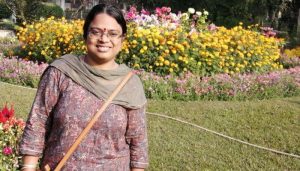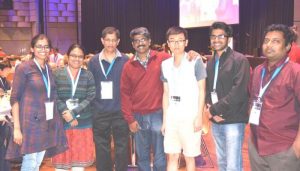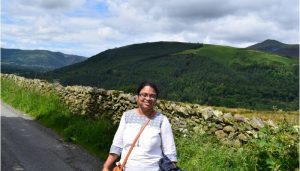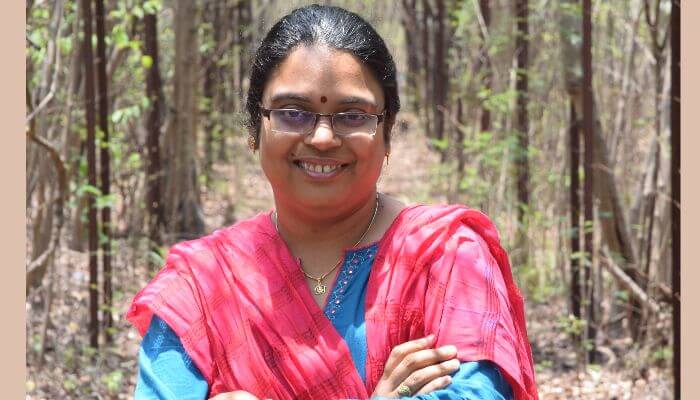As a 17-year-old, it was an encounter with Electronics and Communication Engineering (ECE) faculty prior to choosing an Engineering stream that laid the foundation for her eventful innings in Communication Technology. Now, as faculty at the Signal Processing and Communication Research Centre, IIITH, she is known for her meticulous lecture notes, challenging term projects that involve cutting edge research and exploring diverse facets of coding theory. Meet Lalitha Vadlamani, Assistant Professor, who’s always scouting for digital problems to come up with sophisticated solutions to.
Amidst the ongoing global pandemic, Lalitha Vadlamani exudes positivity during my telephonic conversation with her. “If parts of the world are connected despite the physical isolation, it’s thanks to the power of communication,”she affirms. Among the many pioneers Lalitha credits with the state of advanced digital communication, the likes of Claude Shannon, Andrew Viterbi (the co-founder of Qualcomm) and Elwyn Berlekamp (a coding theory pioneer) find a special mention from her. “The beauty of what they’ve done is that at the right time they’ve come up with very nice algorithms and these are things that are used almost everyday. Plus it is something we can all relate to because these fields are not too ancient. For instance, Shannon came up with his Mathematical Theory of Communication in 1948, a barely 72-year-old topic – not that old at all compared to other engineering disciplines,” exclaims Lalitha.
As part of the young faculty group at the Signal Processing and Communications Research Centre, Lalitha has been teaching core courses such as Digital Signal Processing (DSP), Probability and Random Processes (PRP) as well as some electives like Information Theory and Coding. Terming the teaching experience of the undergraduate 2nd or 3rd year students as “fantastic”, she adds, “I’ve found that everytime I do a new experiment, students surprise me a lot.” To illustrate their creativity, she mentions the ideas that pour in during project assignments. In order to expose the students to and make such project work more compelling, Lalitha handpicks a couple of cutting edge recent research papers which are posed as challenges in signal processing society.
Currently though, Lalitha is enthused about a first year course that is part of a new curriculum, titled Information and Communication. “It’s like an overview course which gives initial core concepts of 3-4 courses which are coming down the line. If Information Theory is offered as an elective and students don’t opt for it, they won’t know concepts so fundamental to the area of communication that we believe every student must be exposed to them. Hence, they are being taught in the first year itself so they can appreciate the field better.” Teaching such a course is fraught with its own challenges though. There’s a fine line between assuming students know much or assuming they know nothing at all. “While some amount of background is needed, if I overwhelm them with too much information, they are likely not to appreciate it,” says Lalitha matter-of-factly. With no single textbook prescribed for this course, Lalitha painstakingly writes down notes for every class lecture which she then shares with the students.

Online Instruction
With teaching having moved temporarily to the online medium, how difficult has it been? “One challenge has been in the fact that I use blackboards a lot. In fact for some of the topics I teach, I have to do only board work. I use a combination of MS Teams along with Notemaker on the iPad, where students can see what I’m writing. Before class, I post my lecture notes and after class, I post my handwritten notes in lieu of a textbook.” Lalitha admits that for online classes, prior preparation helps because feedback in real time does not exist. At the end of the course, in order to get a sense of effectiveness and to evaluate the students, she supplements the coursework with online assessments. It seems to have worked well and the attendance has been good too by Lalitha’s own admission.
Research Projects
Apart from her teaching assignments, Lalitha has been actively involved in a Science and Engineering Research Board project which deals with polar codes and machine learning-based codes. She also consulted in implementing polar codes to a startup titled Wisig Networks, co-founded by a professor from IIT-Hyderabad. Among her other exploits, of special mention is the 2019 Qualcomm Innovation Fellowship awarded jointly to Lalitha and her student Divija Swetha Gadiraju. “Our proposal piqued interest in Qualcomm due to the fact that it is related to applying coding to blockchain. This area is new and it’s only been a year since Divija and I have been exploring it,” explains Lalitha.

Foray Into The Field
Speaking of how she came to study Communication technology itself, Lalitha credits it to her parents’ bias towards the field of Electronics.” My parents and I met the (ECE) faculty at Osmania University before counselling. I didn’t have too much of a preference with respect to either Computer Science or Electronics until then. In hindsight, I’m glad I chose ECE because it does match my interest very well,” says Lalitha. At Osmania University, studying ‘Probability and Random Processes’ in the 3rd year under Prof. PRK Rao turned things around for Lalitha. “He was a retired professor from IIT Kanpur who came to teach at Osmania for 2 years. I was lucky to be in one of his batches. He introduced so many things particularly in Math with so much rigour that I had never seen before.” With that solid foundation, when Lalitha went on to pursue a Masters in Signal Processing at the Indian Institute of Science (IISc), Bangalore, she discovered that she was well ahead in the Probability course. Lalitha found (much to her joy) that there was a lot of unexplored Math in Signal Processing and since she always wanted to do that, she majored in that area at IISc.
Post the Masters, she dabbled in industry working briefly at Honeywell, Qualcomm and Conexant Systems. It was whilst working at the latter that she switched over to Communications. “Though they knew that my expertise was in Signal Processing, they had an opening in Communications and were open to me attempting that. I learned a lot there. It was a kind of a startup team and we were working on a new project where I saw end-to-end development of a product, from giving specs to fabrication. So I saw the complete lifecycle of a particular chip.” While the experience was extremely useful, the love for studying further beckoned. In 2008, Lalitha came back to IISc for a PhD. She signed up under Prof. P. Vijay Kumar who is a renowned coding theorist and went on to complete her PhD in Coding Theory with a myriad of applications. Lying at an intersection of both theory and application, it is a field that she continues to work in even today.
Interdisciplinary in Nature
As faculty at the Signal Processing and Communication Research Centre at IIITH, Lalitha says that the lines between hard core Computer Science and Electronics and Communication Engineering are blurring. “Engineering study is more interdisciplinary today. If each field was on its own, then maybe the toughest problems in the field would have remained unsolved or would take around 15 years to reach a solution. In research, it requires a huge amount of patience to get a single result. Thanks to the interdisciplinary nature of Science, the atmosphere is more vibrant in terms of researchers feeling active about a lot of things”. Speaking of her own peer group at SPCRC, she says with unmistakable pride that they are all working in diverse areas and creating impact in teaching as well as research. “Getting such a peer group even in other top tech institutes is hard. Because typically when somebody joins an institute, for a long time they are on their own. While there is some amount of peer support, it’s generally not as strong as I see here. And that is something which is definitely useful for faculty.”
The Other Side To The Prof
As a long-time active member of the IEEE Signal Processing Society, Lalitha currently chairs the society’s Hyderabad edition. When she is not organizing events and inviting speakers for talks, in her spare time, she can be found trying her hand at whipping up traditional sweets – which is rather surprising since she professes not to have a sweet tooth herself. An armchair expert of tennis, she enjoys discussing the game at length with other colleagues on campus. She is also a regular in the group dance performances that take place in the faculty and staff quarters (FSQ) of the institute during Navratri and Saraswati Puja.
Strongly believing that change is the only constant in life, we often ask faculty and former students about changes they’ve witnessed at the institute over the years. In response, folks talk about generational differences, increasing student strength, lesser interactions with students or faculty, or even changes in the physical landscape itself such as the awkwardly morphing Gachibowli suburb and so on. But ask Lalitha Vadlamani on what she thinks has changed since she joined IIITH as faculty in 2015, and she replies that for her, the change is internal. ”Personally I feel like I have changed a lot by interacting with students since I joined here. (And)..I like that change quite a bit.”




Very inspiring
Swaranjali says: